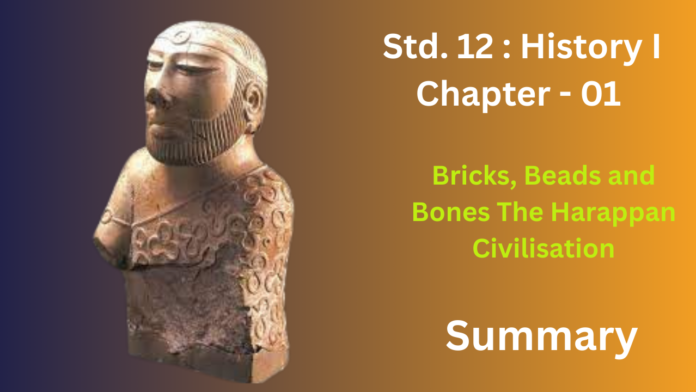“Bricks, Beads and Bones: The Harappan Civilisation” explores the archaeological findings that reveal the existence and characteristics of the Harappan Civilisation, one of the earliest urban centres in the world in the Indus Valley.
The chapter details the discovery of Harappa and Mohenjo-daro, highlighting the planned urban layouts with well-laid-out grids, standardized bricks, and sophisticated drainage systems, indicating advanced town planning. It discusses the distinctive artifacts found, including seals with unique scripts and animal motifs, weights and measures suggesting a system of exchange, and various crafts like pottery, bead-making, and metalworking, showcasing specialized labor.
The subsistence strategies of the Harappans are examined, including agriculture (wheat, barley, lentils, sesame), animal husbandry (cattle, sheep, goats, buffalo), and hunting. The chapter also touches upon the social and economic differences observed in the settlements, though large-scale political structures remain debated.
Exercise
1. List the items of food available to people in Harappan cities. Identify the groups who would have provided these.
Ans:
The people in Harappan cities had access to a variety of food items, including both plant and animal products. Grains such as wheat, barley, lentils, chickpeas, and sesame were commonly consumed. Evidence from sites in Gujarat also suggests the use of millets, while rice finds are relatively rare.
For animal products, the Harappans consumed the meat of domesticated animals like cattle, sheep, goat, buffalo, and pig. Additionally, they also ate the meat of wild species, including boar, deer, and gharial, as well as fish and fowl.
The groups who would have provided these food items likely included:
- Farmers: These individuals would have been responsible for cultivating the various grains and possibly some fruits and vegetables.
- Pastoralists/Herdsmen: They would have reared the domesticated animals, providing meat and possibly dairy products.
- Hunters: These groups or individuals would have hunted wild animals for their meat. It’s unclear if this was a specialized group or if some Harappans engaged in hunting themselves.
- Fishers: They would have provided fish from rivers and possibly coastal areas.
- Gatherers: Some food items, particularly plant-based ones like fruits and nuts, might have been gathered from wild sources.
2. How do archaeologists trace socio-economic differences in Harappan society? What are the differences that they notice?
Ans:
Archaeologists trace socio-economic differences in Harappan society primarily through the analysis of burials and artifacts.
Regarding burials, they note differences in the complexity of burial structures. Some graves are simple pits, while others have brick-lined hollowed-out spaces. Some burials contain pottery and ornaments, including jewelry made of precious materials, suggesting wealth or status. The presence of copper mirrors in some burials is another indicator.
When examining artifacts, archaeologists categorize them into utilitarian and luxurious items. Luxurious items, on the other hand, are rare, made from costly non-local materials, or require complex technologies. Examples include faience pots. The distribution of these luxurious items suggests that they were likely used by wealthier groups.
Differences noticed by archaeologists include:
- Variations in housing: Some houses were larger and more elaborate, possibly indicating the presence of wealthier families.
- Unequal distribution of valuable artifacts: Luxury goods are concentrated in larger settlements like Harappa and Mohenjo-daro, suggesting an uneven distribution of wealth.
- Differences in burial practices: The types and quantities of goods buried with individuals hint at social and economic distinctions.
- Urban planning: While there is overall uniformity, variations in the size and organization of settlements might reflect socio-economic hierarchies or functional differences.
However, it’s important to note that large-scale disparities and evidence of a distinct ruling class, like those found in contemporary Mesopotamian and Egyptian civilizations (palaces, monumental tombs), are not clearly evident in Harappan society, leading some scholars to suggest a more egalitarian early complex society.
3. Would you agree that the drainage system in Harappan cities indicates town planning? Give reasons for your answer.
Ans:
Yes,
The Harappan drainage system was remarkably sophisticated and well-organized, far exceeding that of many contemporary urban centers. It wasn’t a haphazard collection of drains but a carefully designed network integrated into the city’s layout.
Reasons supporting this include:
- Grid Layout Integration: Drains were typically laid out along the planned grid pattern of the streets, suggesting that the drainage system was considered during the initial city design, not as an afterthought.
- Standardized Construction: The use of burnt bricks, which are durable and water-resistant, for constructing the drains indicates careful engineering and a long-term vision for sanitation. The consistent size and quality of these bricks further point to centralized planning and control over resources.
- Connectivity and Hierarchy: Each house was connected to the street drains, and these street drains then emptied into larger channels, demonstrating a clear hierarchy and interconnectedness within the system. This suggests a coordinated effort in planning the flow of wastewater.
- Inspection and Cleaning Provisions: The presence of inspection holes and sumps along the drains indicates an understanding of the need for maintenance and cleaning, which would have required prior planning and possibly a civic authority to oversee it.
- Prevention of Waterlogging and Disease: The efficient removal of wastewater suggests a concern for public health and hygiene, a key aspect of effective town planning. A well-functioning drainage system would have significantly reduced the risk of waterborne diseases.
In conclusion, the scale, sophistication, standardization, and integration of the Harappan drainage system with the overall urban layout provide compelling evidence of conscious and meticulous town planning. It wasn’t simply about getting rid of wastewater; it was about creating a functional and hygienic urban environment through careful design and execution.
4. List the materials used to make beads in the Harappan civilisation. Describe the process by which any one kind of bead was made.
Ans:
- Stones: Carnelian (beautiful red), jasper, crystal, quartz, steatite (a soft stone), agate, lapis lazuli, turquoise, onyx.
- Metals: Copper, bronze, gold.
- Other materials: Shell, faience (a glazed material), terracotta (burnt clay).
The techniques for making beads varied depending on the material. Steatite, being a very soft stone, was easily worked. Some steatite beads were even molded from a paste made with steatite powder, allowing for a variety of shapes beyond the geometrical forms typically made from harder stones.
The process of making a carnelian bead, for instance, involved several stages. The yellowish raw material nodules were first chipped into rough shapes. Then, they were finely flaked to achieve the final form. The characteristic red color of carnelian was often obtained by firing the yellowish raw material and the beads at various stages of production. Finally, the bead was ground, polished to a smooth finish, and a hole was drilled through the center using specialized drills found at sites like Chanhudaro and Lothal so that a string could be passed through it.
5. Look at Fig. 1.30 and describe what you see. How is the body placed? What are the objects placed near it? Are there any artefacts on the body? Do these indicate the sex of the skeleton?
Ans:
Looking at Fig. 1.30, I see a human skeleton laid out in what appears to be a burial. The body is placed in a north-south orientation, with the head towards the north.
Near the skeleton, I observe several pottery vessels placed around it. There seem to be at least three or four pots of different shapes and sizes positioned near the head and feet.
There are also some artifacts placed on or near the body. Specifically, there appears to be some form of ornament, possibly a shell bangle or necklace, located near the neck and upper torso area.
Based solely on this image, it is difficult to definitively determine the sex of the skeleton. While the presence of ornaments might sometimes be associated with female burials in some cultures, this is not a universal rule and requires further skeletal analysis (such as examining pelvic structure and skull morphology) by archaeologists to ascertain the sex. The pottery vessels are common grave goods in Harappan burials and are not typically indicative of sex. Therefore, Fig. 1.30 alone does not provide conclusive evidence about the sex of the individual.
6. Describe some of the distinctive features of Mohenjodaro.
Ans:
One of the most prominent is its well-planned grid layout, with streets and lanes intersecting at right angles, dividing the city into rectangular blocks. The city was also divided into two main parts: the Citadel, a raised area in the west containing public structures, and the Lower Town, a larger residential area.
Another striking feature is the Great Bath, a large rectangular tank in the Citadel, possibly used for ritual bathing. Its precise construction with burnt bricks, gypsum plaster, and a well-maintained drainage system underscores the engineering skills of the Harappans.
Mohenjo-daro also possessed an elaborate drainage system, with interconnected household drains emptying into larger street drains, showcasing a strong emphasis on sanitation. The use of standardized burnt bricks for construction throughout the city, including houses and public buildings, further points to centralized planning and resource management. The presence of a large granary in the Citadel suggests a system for storing surplus agricultural produce. Overall, Mohenjo-daro’s meticulous planning, impressive public structures, and focus on sanitation distinguish it as a major urban center of the Harappan Civilization.
7. List the raw materials required for craft production in the Harappan civilisation and discuss how these might have been obtained.
Ans:
Harappan craft production relied on diverse raw materials obtained through various methods. Locally, they sourced clay, timber, and some stones. Within the subcontinent, they procured materials like carnelian from Gujarat and steatite from Rajasthan and North Gujarat via trade or expeditions. Long-distance trade brought lapis lazuli (Afghanistan), turquoise (Central Asia/Iran), copper (Rajasthan/Oman), and tin (Afghanistan/Central Asia), indicating contact with Mesopotamia and the Persian Gulf. They also likely organized expeditions to resource-rich areas, as seen in settlements near shell sources (Nageshwar, Balakot) and lapis lazuli mines (Shortughai). Thus, the Harappans used local sourcing, regional and long-distance trade, and direct expeditions to acquire necessary materials.
8. Discuss how archaeologists reconstruct the past.
Ans:
Archaeologists reconstruct the past by analyzing material remains through several key steps. First, they excavate sites, carefully digging through soil layers (stratigraphy) to uncover artifacts, structures, and features, noting their position for chronological sequencing. Next, they analyze artifacts, studying their material, form, manufacturing, and decoration to understand technology, economy, and social practices. Dating techniques, both relative (artifact styles) and absolute (e.g., radiocarbon dating), establish a timeline. Biological remains (plant and animal bones, human skeletons) are studied to understand diet, environment, health, and burial practices. Finally, interpretation involves using cultural knowledge, logic, and sometimes experimental archaeology to reconstruct past lifeways, social structures, and beliefs, often drawing cautious analogies.
9. Discuss the functions that may have been performed by rulers in Harappan society.
Ans:
Due to undeciphered writing, the functions of Harappan rulers are debated, but archaeological evidence suggests several possibilities. Urban planning and administration are likely, given the uniform city layouts, standardized bricks, and sophisticated drainage, implying central oversight for construction and labor mobilization. Regulation of trade and the economy is also probable, indicated by standardized weights and measures and the organized procurement of distant raw materials, along with uniform artifacts suggesting control. A role in religious affairs is hinted at by the “Priest-King” statue and religious motifs on seals. Finally, rulers may have been involved in maintaining order and resolving disputes, suggested by fortified citadels and organized city layouts. However, the exact nature of governance, whether a single monarchy or multiple rulers/elites, remains an open question.
10. On Map 1, use a pencil to circle sites where evidence of agriculture has been recovered. Mark an X against sites where there is evidence of craft production and R against sites where raw materials were found.
Ans:


